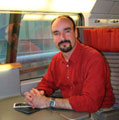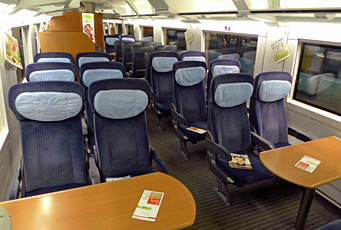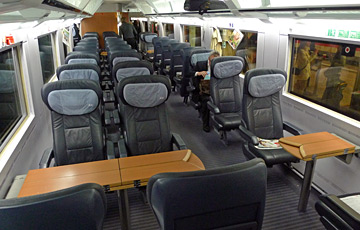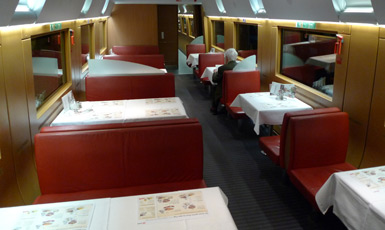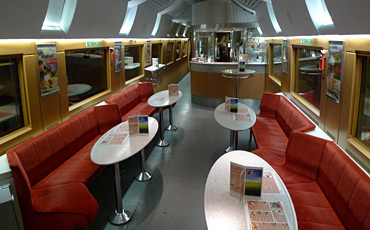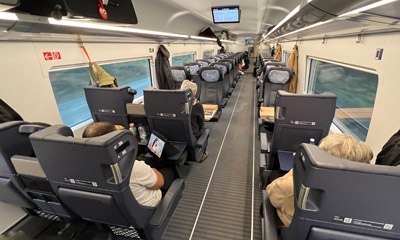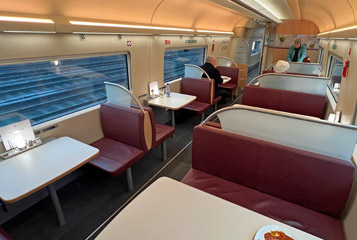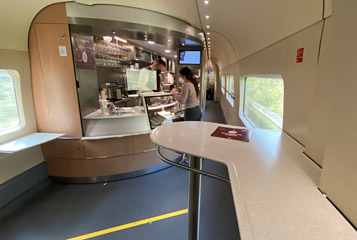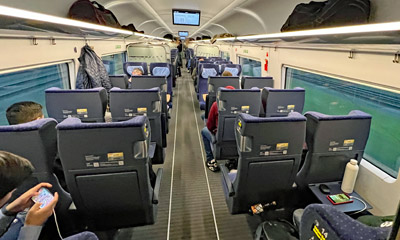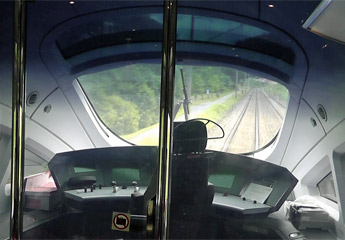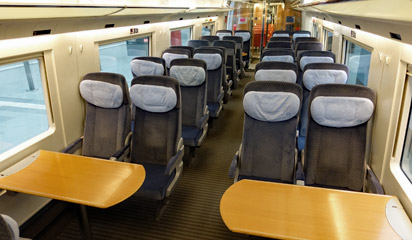Buy ICE ticketsfrom €18.90 atint.bahn.deBuy direct from Deutsche Bahn with fares from €18.90 upwards, no booking fees, on ICE & IC trains you can usually pick specific seats from a seating plan, and in most cases you simply print your own ticket. Definitely register when prompted, so you can log in & check or re-print tickets at any time. |
What is an ICE?
ICE - InterCity Express - is the brand name for Deutsche Bahn's (German Railways) premier high-speed trains. There are various types, some of which can run at up to 300 km/h (186 mph) on Germany's high speed lines and up to 230km/h (130 mph) on upgraded conventional lines. The ICE is arguably Europe's most comfortable, civilised & impressive high-speed train, with a very high-spec interior including free WiFi, power sockets at all seats, and a restaurant car.
![]() Travel tips: WiFi, catering, choosing a seat...
Travel tips: WiFi, catering, choosing a seat...
![]() See this month's restaurant car menu
See this month's restaurant car menu
Which ICE operates which route?
Paris-Germany ICEs are ICE3 class 407.
Brussels-Cologne-Frankfurt ICEs are ICE3 class 408 ICE3neo (replaces ICE3M from June 2024).
Amsterdam-Cologne-Frankfurt ICEs are ICE3 class 408 ICE3neo (replaces ICE3M from June 2024).
Vienna-Germany ICEs are ICE-T, 7-car type.
Switzerland-Germany ICEs may be ICE1, ICE-T or (mostly) ICE4.
Cologne-Hannover-Berlin ICEs are ICE2. Hamburg-Berlin is a mix of ICE1 and ICE4.
Tip: To find out which type operates which train, look up the train at int.bahn.de and check the train number. Then look up that train at www.fernbahn.de/datenbank/suche.
ICE1 & ICE 2 run at up to 280 km/h (174 mph) when using the new high-speed lines. They have the most impressive interiors of all the ICEs. ICE1 runs routes into Switzerland, but is being replaced by ICE4. ICE2 operates the Cologne-Ruhr-Hannover-Berlin ICE service. Virtual tour ICE1. Virtual tour ICE2. Seat map ICE1. Seat map ICE2.
ICE 3
ICE3s can run at up to 300 km/h (186mph) in Germany and up to 320 km/h (199 mph) on high-speed lines in France. They come in 4 variants:
ICE3 class 403 operates various other German domestic routes including Cologne-Munich, see class 403 seat map.
ICE3M class 406 now operates domestic routes in Germany. They used to operate Brussels-Cologne-Frankfurt & Amsterdam-Cologne-Frankfurt services, but were notorious for software problems, in June 2024 the newer more reliable ICE3neo class 408 took over both those routes. Virtual tour ICE3M. ICE3M class 406 seat map.
ICE3 class 407 is a close cousin of Eurostar's e320, they operate Frankfurt-Paris, see photos of an ICE class 407. See class 407 seat map
ICE3neo class 408 took over all Brussels-Cologne-Frankfurt & Amsterdam-Cologne-Frankfurt services in June 2024, they also run on various routes in Germany. Unlike other ICE3 trains, ICE3neo has 8 spaces for bikes in the 2nd class end car. Two different interiors are in service, later ICE3neo trains have a new-design interior (see the photos below) featuring more natural wood and grey fabric seats in 1st class rather than black leather. See class 408 seat map.
An ICE3neo at Amsterdam Centraal. Click on the interior images for larger photos.
ICE4
This addition to the ICE family can only travel at 230 km/h, 250 km/h or 265 km/h depending on the type. They run on various German domestic routes including Hamburg-Cologne-Frankfurt-Munich, and they've taken over many Hamburg-Switzerland & Berlin-Switzerland services from ICE1. One key difference from previous ICEs is that ICE4 carries bikes, with 8 bike spaces. ICE4s have a similar interior to the other ICEs, most with a restaurant car. ICE4 is a nice train, but it appears to be a cut-price version when you compare it to the glitzy ICE1/2/3. See the video, Berlin to Munich by ICE4.
An ICE4 at Munich Hbf. Click on the interior images below for larger photos.
ICE-L
The first ICE-L trainsets are due to enter service in late 2024, replacing Intercity trains on the Amsterdam-Berlin route. The L stands for Low-Floor, as unlike all other ICEs these trains are composed of a locomotive pulling or pushing little articulated carriages built by the Spanish Talgo company. Each ICE-L car is half the length of a conventional ICE car and articulated to its neighbour with just two wheels under each articulation, rather than a conventional 4-wheel bogie. Like other ICEs, they will have 1ast & 2nd class, power sockets, WiFi and a restaurant car. Unlike most other ICEs, they will have spaces for bikes.
ICE-T
ICE-T can run at up to 230 km/h (143 mph). Fitted with a tilting body so it can corner faster on conventional routes, the ICE-T is similar in appearance and interior to ICE3, but with a slightly blunter nose. Some ICE-Ts have 7 cars and feature a restaurant car, other ICE-Ts have 5 cars with a smaller bistro car. Seating is similar to ICE3. You'll find ICE-T on routes such as Vienna-Nuremberg-Frankfurt (7-car version) and the direct Vienna-Berlin ICE is also an ICE-T 7-car. 7-car ICE-T trains now have spaces for 3 bikes. Virtual tour ICE-T. ICE-T 7-car seat map. ICE-T 5-car seat map.
Restaurant car on a Vienna-Frankfurt ICE-T. Take a seat at any table and the waiter will take your order. At the other end of the car is a counter where you can buy snacks, drinks & food to take back to your seat. In 1st class, staff take you food & drink orders and serve you at your seat, you don't need to visit the restaurant.
Most seats are open plan, similar to ICE3. However, an unusual feature of the ICE-T is these two 1st class 4-seat semi-compartments in one of the cars, ideal for families, small groups or a business meeting on the rails. Opposite these semi-compartments are a couple of tables-for-two, my favourite configuration.
Travel tips
-
Seat maps for ICEs: Click here.
When booking at int.bahn.de you can usually select seats from a seat map on ICEs.
-
Should you go 1st or 2nd class?
2nd class is perfectly adequate. But if you get a good price, 1st class gives you more leg & elbow room and usually a quieter environment, with more laptops tapping and fewer kids. The only real difference is the seating comfort, see the photos on this page, but in first class food & drink orders are taken by a steward so you don't have to go to the restaurant car, a useful service.
In 1st class seats are arranged 2+1 across the car width, so you'll find face-to-face tables for two and solo seats on one side of the aisle.
-
Open saloon or compartment?
The majority of seats on an ICE is in open-plan saloons as shown in the photos on this page, but on some types of ICE there are a few 6-seat compartments in both classes which you can select when booking. Virtual tour of an ICE1. Virtual tour of an ICE3.
-
Table seats
If you select table when booking you'll get seats at a fixed table for four or table for two, although all seats have a drop-down table even if they aren't at a fixed table. Tickets usually say Tisch (German for table), if your seat is at a fixed table. When travelling as a couple, a face-to-face table-for-two in first class is easily the best option. As a family of four, a table seat is the best and most sociable option in 1st or 2nd class.
-
Fares, ticketing, seat reservations
You can book at int.bahn.de and print out your own ticket. Booking for most ICEs opens up to 6 months before departure.
Reservation is compulsory on the ICE trains to/from Paris and tickets on the Paris route always come with a seat reservation included, free of charge. On other ICE routes seat reservation is usually optional for a small extra charge of €5.20 in 2nd class, €6.50 in 1st class.
If you don't have a reserved seat you just find any empty unreserved seat, as shown by the little LED reservation display above every seat. That means you can always buy a full-price ticket and get on the next train, ICE trains can never sell out. However, a seat reservation is a good idea for a long journey and you will find much cheaper fares if you are willing to commit to a specific train with a limited-refund, limited-changes Sparpreis ticket booked in advance at int.bahn.de.
Update 2024: Seat reservation is compulsory on all cross-border ICEs from 1 June to 1 September 2024.
-
Boarding
As with most European trains, there's no check-in, you just walk into the station, look at the departure screens to find your train and get on, any time before it leaves. Exterior displays next to each carriage door show the train number, destination, calling points & car number. Information displays inside each carriage also show the train's destination, carriage number, calling points, the next station stop and (from time to time) the train's speed. On board announcements are usually made in both German and English.
-
On the seat reservation displays above each seat
Small LED displays above each seat show which seats are reserved between which stations. You may see these messages:
ggf. freigeben - this is a last-minute reservation seat. You can sit in it if you like, but will have to move if someone shows up with a reservation.
ggf. reserviert - this means the train's on-board reservation system hasn't been updated with the latest information from the main DB reservation system. Usually all of the seats show this message if this happens. Seat reservations are still valid, but cannot be shown on the LED displays, so you can sit in these seats but you could be asked to move if someone shows up with a reservation.
bahn.comfort - travellers holding a frequent traveller BahnCard have priority for these seats. You can sit in these seats but someone with a BahnCard may show up and claim it. Though how they'd know you didn't have a BahnCard and so ask you to move is another question!
Schwerbehinderte means that seat is reserved for people with disabilities.
-
First class lounges
If you have a first class Flexpreis ticket, but not an advance-purchase Sparpreis or Super Sparpreis fare, you can use the DB Lounges at the following stations, typically open 07:00-21:00: Berlin Hbf, Bremen, Dresden Hbf, Düsseldorf, Frankfurt am Main Hbf, Frankfurt Main Airport, Hamburg Hbf, Hanover, Cologne Hbf, Leipzig Hbf, Mannheim, Munich Hbf, Nuremberg Hbf, Stuttgart Hbf. These have free WiFi & complimentary refreshments including beer & wine.
You can use the NS Lounge at Amsterdam Centraal with any type of 1st class ticket, and the ÖBB Lounge at Vienna Hbf with any type of 1st class ticket except Super Sparpreis.
-
Luggage
You take your bags with you and put them on any suitable luggage rack near your seat. If you can carry it you can take it, as within reason there are no baggage limits. The overhead racks above all seats will take anything up to backpack-sized. There are floor-standing racks for larger items inside the passenger saloons, so you can put your big bags near where you're sitting.
-
Bicycles
Bikes are not carried on any ICE1, ICE2, ICE3 or ICE-T train, unless they are semi-dismantled and placed in a zip-up bike bag as regular luggage, see the bikes by train page. However, ICE4 & ICE3neo have 8 bike spaces for fully-assembled bikes.
To book your bike, use int.bahn.de and add a bike to the passenger details.
-
Dogs
You can take a dog on ICEs, see the dogs by train page. You can add a dog when you book at int.bahn.de.
-
WiFi & power sockets
All ICEs have free WiFi in both classes. In 2nd class there is limited bandwidth, you can check emails and browse the net but you can't watch videos or download large attachments. In 1st class there's no artificial limit on bandwidth so you can access larger files & video. There are power sockets at all seats of the usual European 2-pin type.
To use the free WiFi, select the WIFIonICE network in your WiFi settings. This normally opens the landing page LogIn.WIFIonICE.de but if it doesn't you can open that link in a browser manually.
-
Food & drink
ICE1, ICE2, ICE3 class 407, & 7-car ICE-T trains have a proper restaurant car with a restaurant at one end and a bar area at the other. ICE3 class 403 & 406 and 5-car ICE-T trains have a bistro-restaurant with a cafe-bar area and small 12-seat restaurant area. In ICE 1st class, orders are taken by a member of staff and drinks and food are served at your seat, all using proper china & glassware. You can't reserve a table in the restaurant car and don't need to, you just go along and sit in any free seat.
If you are a red wine fan, DB's Spätburgunder red (Pinot Noir) is lovely. If you prefer beer, DB serves excellent Erdinger Weissbier in a distinctive tall Erdinger glass, highly recommended.
DB's menu for the current month is at www.bahn.de/service/zug/bordgastronomie, click the Speisen & Getränke links at the bottom of that page -please let me know if that link stops working.
You are of course free to bring your own food and drink along if you prefer and consume it at your seat, as on any European train.
-
Children
ICE1 & ICE2 have baby-changing facilities and a small play area in a 'parent & child' compartment. ICE3 also has baby-changing facilities. Infants go free and with German Sparpreis & Super Sparpreis fares children under 15 often go free too. More about child age limits on European trains.
-
Viewing screen behind the driver
ICE3 classes 403 & 406, ICE-T & ICE-TD trains have a seating area at each end of the train (one end 1st class, the other 2nd class) with a glass screen behind the driving cab, giving you a view along the track ahead or behind the train. See the photo above. Though you'll find Dutch and Belgian drivers switch the glass to opaque!
The ICE3 classes 407 & 408 don't have a viewing area as there's an electrical equipment section between cab and passenger accommodation.
See this month's bistro & restaurant menu
-
You can find DB's menu for the current month in both html & pdf formats at www.bahn.de/service/zug/bordgastronomie, just click the Speisen & Getränke links at the bottom of that page -please let me know if that link stops working.
